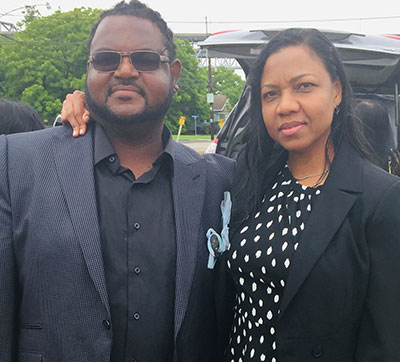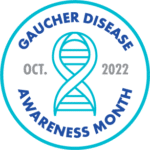As part of Gaucher Disease Awareness Month, we’re sharing stories from Gaucher patients, family, and caregivers about their experiences and their journeys.
Want to share your story? Contact us and we’ll be in touch.
The following, as conveyed by Hermain Joseph about her family, is slightly edited for formatting and style.
Tell us about your beginnings with Gaucher disease. How did you learn about it?

I first learned about Gaucher disease about 40 years ago. Rod, my younger brother, suffered from an unknown illness as a toddler and was always hospitalized. Because the doctors could not diagnose Rod, my mother took him to the United Kingdom to get medical attention. My family learned about Gaucher disease from that UK visit.
Later, when being tested as bone marrow donors to Rod, my family learned that my youngest brother, Truddy, also has Gaucher disease. St. Lucia did not and probably still does not have medical knowledge or treatment for Gaucher disease.
The symptoms Rod and Truddy commonly shared were swollen [pot] belly from an enlarged spleen and malnutrition (appearance). They both bruised easily, had night sweats, and were bleeders. For example, if they had cuts, the bleeding would stop from applying a prescribed coagulating solution. The white part of Rod’s eyes were yellowish.
After my mother’s death, Rod and Truddy emigrated to the United States to get care for their Gaucher disease. Rod and Truddy participated in a clinical trial in the early ’90s. They became the first patients in the United States to receive Cerezyme therapy. Rod and Truddy received enzyme replacement therapy (ERT) intravenously every two weeks.
Together, Rod and Truddy have been receiving ERT for 28 years. Truddy switched to Cerdalga, an oral version of the ERT, about 2 years ago.
Even with 28 years of treatment, Truddy suffers from brittle bones, bone pain, and weight gain. In 2010, Truddy suffered broken femurs from complications of his Gaucher disease. We lost Rod to liver failure in December of 2016.
How did you get connected with the National Gaucher Foundation? How has NGF helped you in managing your Gaucher disease and everything that comes with it?
My family made connection with the National Gaucher Foundation (NGF) through a Genzyme Case Manager.
Over the past 25-30 years, NGF has provided much needed financial support to Rod and Truddy. NGF helps Truddy with the high monthly premiums and other related expenses (such as medical travel) that he needs to obtain health insurance to receive care or manage the disease.
Without this financial assistance, the cost to manage Truddy’s disease would be insurmountable for my family. Additionally, the Foundation has connected me with physicians specialized in Gaucher disease whenever Truddy needed to relocate. Many years ago, it was difficult to find doctors specialized in Gaucher disease unless you were in a network, like NGF.
What message do you want to share with patients and families that are just beginning their Gaucher journey? Are there any lessons you’ve learned that you think they should know?
Fortunately, there is more information available today on Gaucher disease than there was 20 years ago.
Getting started and establishing a system to manage your care may seem overwhelming at first. Read about the disease, know your symptoms and how the disease is affecting you. With my brother Rod, his liver was affected by the Gaucher whereas with Truddy, the disease affects his bones.
Ensure your Gaucher physician is involved in your care if you are hospitalized for other reasons. Doctors have previously misdiagnosed Truddy with bone cancer or tumors because of his Gaucher disease.
The ERT drug is very costly. Truddy and Rod always needed to have health insurance and copayment assistance. Even with drug manufacturer discount, they could not afford the ERT drug. The NGF website provides a list of organizations that can provide financial support to Gaucher patients if eligible.
It is important to follow-up and interact with your physician to prevent a lengthy break in care, and ensure the drug and dosage prescribed are effective. Even if you feel or look healthy, do not skip your ERTs and complete all lab work recommended by your Gaucher physician.
Because Rod went about 5 years without ERT, it triggered his prior debilitating liver problem. Rod passed on two years after resuming his ERT therapy. Patients should be diligent when managing their Gaucher disease. ERT will slow the severity of the disease, however ERT is not a cure.
Is there anything that you think the general public should know about Gaucher disease and the greater Gaucher community?
I do not believe Gaucher disease is widely known to the general public. There should be more scientific research, and the pharmaceutical and medical community should create more awareness about Gaucher disease. Because patients experience debilitating symptoms and bi-weekly ERT infusion appointments can disrupt work schedules, Federal and State laws should identify Gaucher disease as a disability.
My family knows too well how terminal Gaucher disease is without financial support and medical treatment.
If you could describe the Gaucher community in a few words or phrases, what would you say?
Over the past 20 years, the Gaucher community has provided excellent service, consistent support, and great care to Rod and Truddy.
Thank you Gaucher community for taking care of Rod and Truddy, and being a part of my family. A special thanks to the NGF for the past 20 years.

